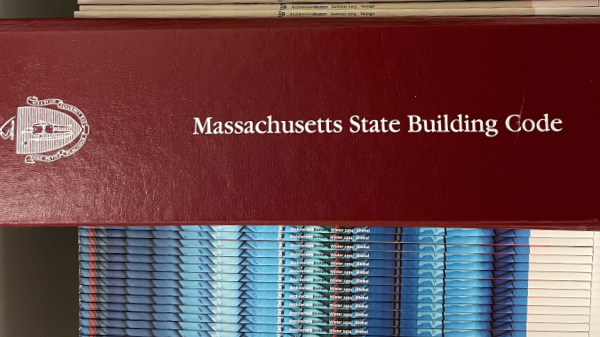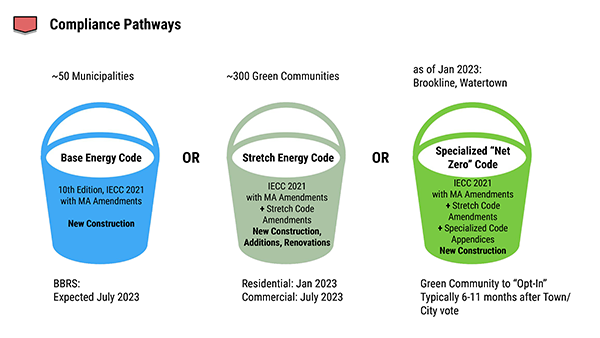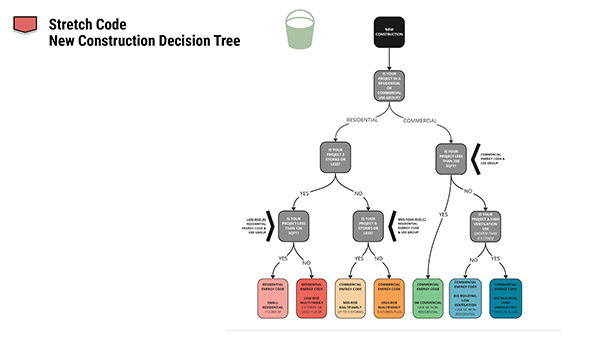The 2023 Energy Code Updates Are Here—Are You Ready?

The Massachusetts Department of Energy Resources (DOER) recently released the updated building energy code with regulations intended to help move toward the state’s goal of reaching net-zero emissions by 2050. The changes are significant, and architects, engineers, and the rest of the building-industry community will need to be well versed in these codes if the state is to reach its ambitious goal.
Background
Buildings account for an estimated 40 percent of all greenhouse gas emissions and nearly 70 percent in urban areas. With that in mind and with the passage of the Green Communities Act in 2008, in 2010 Massachusetts enacted its first stretch energy code (an addition to the base energy code, which all architects must follow to be compliant in Massachusetts), with an emphasis on energy-efficient cost-effective construction. Since 2010, 300 Massachusetts cities and towns have adopted the stretch code. This year’s update added a third energy code, a specialized municipal opt-in stretch energy code, “to ensure new construction that is consistent with Massachusetts greenhouse gas limits.”
Breakdown of the Codes
Under the new regulations, each municipality in Massachusetts must apply one of the following three stretch codes, outlined as follows:
- Base energy code: applies to both new construction and renovation work; approximately 50 Massachusetts municipalities have not adopted the stretch code (and therefore are not designated Green Communities), so the base energy code is the default code for these municipalities. This code’s provisions are located within the 780 CMR state building code. Although changes to this code are slated to go into effect in July 2023, the new Governor’s administration has not yet finalized the specific date.
- Stretch energy code: applies to new construction, additions, and renovations; approximately 300 Massachusetts municipalities (aka “Green Communities”) have adopted this code; the code creates stricter guidelines on energy efficiency for new construction and alterations in municipalities that are designated Green Communities; this code formerly applied to commercial buildings only but now also applies to residential work. The provisions are located within DOER’s newly promulgated 225 CMR.
- Specialized net-zero opt-in code: applies to new construction and is designed to help ensure that new construction is consistent with a net-zero economy by 2050; to adopt this code, a municipality has to vote to opt in, and the code becomes enforceable, at a minimum and no maximum, six months after the city/town council vote; as of this writing, five Massachusetts municipalities have opted in. The provisions are located within DOER’s newly promulgated 225 CMR.

[Image from "DOER Critical Stretch Codes Fundamentals."]
The requirements that architectural teams will apply to each project will depend on the energy code adopted by the municipality where the permit application will be filed.
The biggest takeaways
Among the most notable takeaways of the 2023 updates is the addition of a third net-zero option, the municipal opt-in specialized stretch energy code. Also notable are the changes regarding the stretch code: the stretch code, which formerly applied to very large buildings, now applies to every project.
According to Andrea Love FAIA, director of building science at Payette and president of the BSA/AIA Board of Directors, the building envelope requirements in the opt-in code, in particular, represent some of the biggest changes in the code. “We will not be able to design all-glass buildings anymore,” she says. “We must look at the code first and then think about design—not the other way around. This is a shift in how we design façades.”
Alison Nash AIA, associate and sustainability coordinator at Sasaki Associates, concurs, adding that building design requires an approach that involves bringing together building design specialists: “It’s going to force people who have designed based only on form and aesthetics to look at integrated design as the new normal.”
Katie Raymond PE, LEED AP, senior engineer at Epsilon Associates, an environmental engineering and consulting company in Maynard, Massachusetts, considers the three key takeaways (all of which will come at a cost) in the new regulations to be triple glazing, mandatory buildout for current or future electrification, and an air infiltration testing requirement, which are discussed in this Epsilon article.
Leveling the playing field
The code changes are “one tool in the state’s tool belt to reach 80 percent reduction in all greenhouse gas emissions,” says Nash. She goes on to note how these changes level the playing field: “The new, minimum energy code requirements enable the whole Commonwealth to reach emissions levels quicker with technology that already exists. The code is forcing the hand.”
Resources
The following list of resources provide more information and guidance in interpreting the latest code changes:
- 2023 Technical Guidance: Massachusetts Stretch Energy Codes guide released in December 2022. This is a “must-read,” says Senior Associate and Sustainability Strategist Lara Pfadt AIA of Finegold Alexander Architects
- “DOER Critical Stretch Code Series” presentation hosted by the BSA Codes Committee
- DOER’s Summary of State Building Energy Codes including the Stretch Code
- The Unofficial 10th Edition Base Code Draft (code book). The BSA will be offering training sessions on this.
- Mass Save, in coordination with the Board of Building Regulation and Standards (BBRS) and DOER, sponsors training on the building energy code, including the Stretch Code and Specialized Code, at various locations around the state.
- A timeline that illustrates when the codes go into effect (from the “DOER Critical Stretch Code Series” presentation):
- December 23, 2022: Technical guidance documents are released
- January 1, 2023: The residential stretch code comes into effect.
- April 2023 to June 2023: Town meetings vote on the opt-in code; 6 to 11 months later, the opt-in code takes effect.
- July 1, 2023: The commercial stretch code goes into effect; the base energy code goes into effect.
- January 1, 2024: The opt-in stretch code for multifamily housing less than or equal to five stories to meet Passive House goes into effect.
- July 1, 2024: Lower Home Energy Rating System (HERS) value for residential; relative performance path ends for commercial multifamily; opt-in stretch multifamily greater than six stories to meet Passive House
- Another tool to help visualize the stretch code is this decision tree, shown in the “DOER: Critical Stretch Code Series” presentation sponsored by the BSA Codes Committee:

[Image from "DOER Critical Stretch Codes Fundamentals."]
The BSA will be hosting workshops on the codes. Stay tuned for updates to come.

